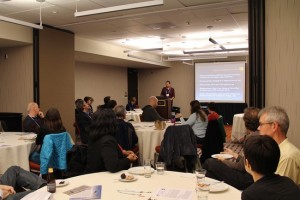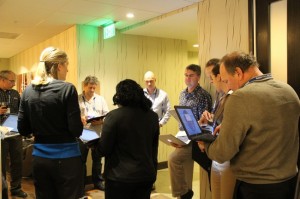AGU Fall Meeting 2013, San Francisco, USA
Conveners Part 2: D. Sarah Stamps4, Wendy Nelson5, Robert Moucha6, Andy Nyblade7
1University of Idaho; 2University of Rochester; 3University of New Mexico; 4MIT; 5University of Houston; 6Syracuse University; 7Penn State University
The AGU GeoPRISMS Mini-Workshop on Collaborative Efforts in the East African Rift System was held Thursday evening, 12 December 2013 at the Grand Hyatt hotel in San Francisco during the AGU Fall Meeting. It was well attended with 50 participants, 9 of whom were graduate students and 7 were postdoctoral researchers. This workshop had two sections sharing a common theme of bringing scientists together to discuss collaborative efforts underscored by the GeoPRISMS East African Rift System (EARS) implementation plan.
Part 1. The Eastern Branch Focus Site
Ongoing research programs in the Kenya-Tanzania rift sector were briefly reviewed as a foundation for scientific planning, and as experiential learning in terms of data acquisition and collaboration. These studies show high levels of seismicity, fault activity, and gas emissions in this magmatically-active region, which spans basins that formed at 25 Ma to < 1 Ma. The age span enables studies of rift initiation, propagation, and evolution within one sector. Presenters outlined existing data sets acquired by academics, petroleum, mineral, geothermal exploration, and governmental organizations.
Coordination of field programs and collaborative training opportunities enables fuller, more rewarding interactions with our international colleagues and provides more effective liaison with the relatively small EAR research community. For example, Fischer outlined strong support offered by geothermal exploration and production teams in Kenya.
Presenters outlined the procedure to obtain research permits in Kenya and Tanzania, as well as potential collaborating institutions. Attention was drawn to the USAID PEER program, which enables African collaborators to seek separate funding for enrichment of participation in NSF-funded research.
Part 2. Synoptic Studies of the East African Site
The GeoPRISMS initiative offers an unprecedented opportunity to synthesize EARS data and models for an improved understanding of the fundamental geodynamics of continental rifting. In 2012, during the GeoPRISMS EARS planning workshop, the community identified synoptic investigations along the entire EARS as a Collaborative Target of Opportunity. The initial questions posed in the implementation plan motivate studies of the mechanisms enabling rifting of cratonic lithosphere, the origin, composition, and timing of volcanism, the rate and distribution of strain along and across the rift systems, and large-scale pre-rift structure and dynamics underpinning the rift system.
Part 2 of the Mini-Workshop centered on obtaining feedback from participants in real-time. We presented three questions for discussion and report responses to each:
What questions are of interest to the community that concern synoptic studies of the EARS?
What datasets exist and what is needed to address system-wide studies of the EAR?
Is there interest in a community-driven proposal?
Given the recorded responses at the AGU Mini-Workshop, there is some interest within the GeoPRISMS community to develop a community-driven proposal to address synoptic studies of the EARS as evidenced by 50% of the responses.
Acknowledgements
We thank the GeoPRISMS Program of the National Science Foundation for funding this workshop, the moderators who volunteered to record participant responses in real-time to on-line documents using their personal computers, and the GeoPRISMS chair for providing Internet connectivity during the workshop.
Reference informationGeoPRISMS Newsletter, Issue No. 32, Spring 2014. Retrieved from http://geoprisms.nineplanetsllc.com


